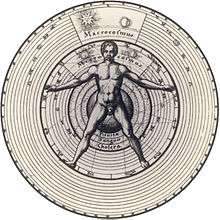Macrocosm and microcosm


Macrocosm and microcosm refers to a vision of cosmos where the part (microcosm) reflects the whole (macrocosm) and vice versa. It is a feature "present in all esoteric schools of thinking", according to scholar Pierre A. Riffard.[2] It is closely associated with Hermeticism and underlies practices such as astrology, alchemy and sacred geometry with its premise of "As Above, So Below".[3]
Today, the concept of microcosm has been dominated by sociology to mean a small group of individuals whose behavior is typical of a larger social body encompassing it. A microcosm can be seen as a special kind of epitome. Conversely, a macrocosm is a social body made of smaller compounds. In physics, scale invariance describes the same phenomenon, although the universe as a whole is not physically scale invariant according to the modern understanding. However, scale invariance does appear in some physical systems, such as electrical breakdown.
This theory was initiated by Pythagoras who saw the cosmos and the body as a harmonious unity. He expressed this connection with his concept of microcosm and macrocosm.[4]
See also
References
- ↑ Robert Fludd in Utriusque Cosmic Historia, II; quoted by Pierre A. Riffard in Dictionnaire de l’ésotérisme, Paris: Payot, 1983, 34.
- ↑ Pierre A. Riffard, Dictionnaire de l’ésotérisme, Paris: Payot, 1983, 34.
- ↑ Antoine Faivre, Access to Western esotericism, State University of New York Press, 1994, 10-11.
- ↑ "Harmony in Healing". 2017-07-28: 15–16. doi:10.4324/9780203790281.
- Republic, Plato, trans. By B. Jowett M.A., Vintage Books, NY. § 435, pg 151
Bibliography
- Theories of Macrocosms and Microcosms in the History of Philosophy, G. P. Conger, NY, 1922, which includes a survey of critical discussions up to 1922.
External links
| Wikisource has the text of the 1921 Collier's Encyclopedia article Microcosm and Macrocosm. |
- Cosmos - an Illustrated Dimensional Journey from microcosmos to macrocosmos - from Digital Nature Agency